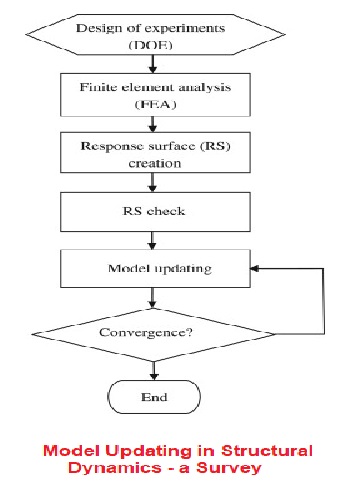Admin
مدير المنتدى


عدد المساهمات : 18992
التقييم : 35482
تاريخ التسجيل : 01/07/2009
الدولة : مصر
العمل : مدير منتدى هندسة الإنتاج والتصميم الميكانيكى
 |  موضوع: بحث بعنوان Model Updating in Structural Dynamics - a Survey موضوع: بحث بعنوان Model Updating in Structural Dynamics - a Survey  السبت 20 أغسطس 2022, 8:53 am السبت 20 أغسطس 2022, 8:53 am | |
| 
أخواني في الله
أحضرت لكم
بحث بعنوان
Model Updating in Structural Dynamics - a Survey
J. E. Mottershead
Department of Mechanical Engineering, University College of Swansea, Singleton Park,
Swansea SA 2 8PP, Wales
AND
M. I. Friswell
Department of Mechanical and Electrical Engineering, Aston University,
Birmingham B4 7ET, England
(Received 8 September 1992, and in final form 21 May 1993)

و المحتوى كما يلي :
It is well known that finite element predictions are often called into question when they
are in conflict with test results. The area known as model updating is concerned with the
correction of finite element models by processing records of dynamic response from test
structures. Model updating is a rapidly developing technology, and it is intended that this
paper will provide an accurate review of the state of the art at the time of going to press.
It is the authors’ hope that this work will prove to be of value, especially to those who are
getting acquainted with the research base and aim to participate in the application of model
updating in industry, where a pressing need exists.
CLOSURE
In this paper, a thorough description of the state of the art in finite element model
updating has been provided. It is the authors’ opinion that the most promising techniques
now need to be tested in an industrial environment. In the aerospace industry the need
for test-verified finite element models has long been recognized. However, the approach
used in practice is still based on fitting model parameters to test data by trial and error
methods. In the motor industry the speed with which new models can be brought to the
market has proved to be increasingly critical. A particular design obstacle is the interaction
of structural vibration modes with acoustic modes in the passenger compartment. The
application of model updating methods can lead to the rapid development of improved
vibration and acoustic models.
While successful results have been reported for many of the approaches described
previously in this paper, it is vital that such approaches are capable of handling problems
of industrial dimensions. The reported results are often obtained by using data from
laboratory test structures to update models with no more than a few hundred degrees of
freedom. Finite element models with tens, or hundreds, of thousands of degrees of freedom
are commonplace in industry, and the updating of such large models now poses a major
intellectual challenge to the researchers.
The authors hesitate to recommend “preferred” updating approaches. However, certain
directions appear to be sensible in view of the strongly under-determined nature of the
updating task. The preliminary elimination, through localization, of certain members of
the set of candidate updating parameters is clearly helpful. So too is the use of test
data from multiple test configurations (static as well as dynamic), and regularization
techniques can be used to improve the conditioning of the problem, and may result in a
solution closely neighbouring a solution with physical meaning. The research conducted
in these areas has, in the main, been closely coupled to the use of sensitivity based
approaches. Those methods in which eigendata sensitivities are used (rather than FRF
sensitivities) are particularly robust, and appear to be well suited to industrial model
updating problems.
It is considered that a need exists for the use of confidence levels which might be assigned
to quantified mesh, or test data, uncertainties. Such confidence levels should be used
together with the sensitivities at both the localization and the updating stages. At a more
basic level, guidance needs to be provided in the preparation of finite element meshes for
updating. In present updating procedures one assumes that the initial model is fixed with
respect to the mesh configuration, boundary conditions and type of element. Methods need
to be put in place which will allow the selection of a “most suitable” initial model from
a set of candidates. Further work needs to be conducted on the elimination of systematic
errors from both the measurements and the finite element model.
كلمة سر فك الضغط : books-world.net
The Unzip Password : books-world.net
أتمنى أن تستفيدوا من محتوى الموضوع وأن ينال إعجابكم
رابط من موقع عالم الكتب لتنزيل بحث بعنوان Model Updating in Structural Dynamics - a Survey
رابط مباشر لتنزيل بحث بعنوان Model Updating in Structural Dynamics - a Survey 
|
|







